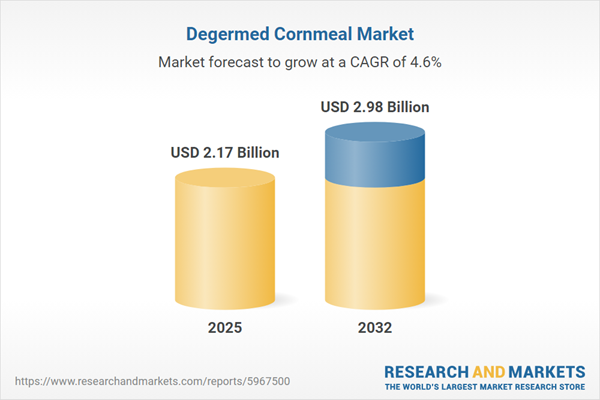Speak directly to the analyst to clarify any post sales queries you may have.
The degermed cornmeal market is experiencing notable transformation as companies respond to shifting dietary demands, tightening regulations, and the rising necessity for flexible, high-quality ingredients. Senior decision-makers are adapting strategies across sourcing, production, and logistics to remain competitive and resilient in this fast-evolving environment.
Market Snapshot: Degermed Cornmeal Market Outlook
The global degermed cornmeal market is projected to grow from USD 2.07 billion in 2024 to USD 2.17 billion in 2025 and is expected to reach USD 2.98 billion by 2032, signaling a compound annual growth rate (CAGR) of 4.63%. This steady expansion is fueled by robust demand within food processing, the broadening utilization of cornmeal across consumer and industrial applications, and an industry-wide move toward clean-label ingredients. Senior leaders are prioritizing product innovation, strengthening transparency in procurement and logistics, and developing agile supply chain strategies to address market shifts and evolving customer expectations.
Scope & Segmentation in the Degermed Cornmeal Market
- Product Types: Mixed, white, and yellow degermed cornmeal support tailored product development for a spectrum of food manufacturers and specialty providers. Varied offerings align with a diverse set of industrial uses and consumer preferences, supporting flexible business strategies.
- Form Consistencies: Coarse, medium, and fine textures enable businesses to address specific performance needs, whether for culinary innovation, product formulation, or industrial processing requirements.
- Application Fields: Degermed cornmeal is widely utilized in baked goods, breakfast cereals, snacks, tortillas, chips, biofuel manufacturing, and starch production. These broad applications highlight its importance for both food and non-food industries.
- Distribution Channels: E-commerce, foodservice distributors, and traditional retail channels enable companies to address fluctuating demand and support improved delivery efficiency, providing critical logistical flexibility in B2B transactions.
- End User Categories: Segments include direct consumers purchasing for food use, food production organizations integrating cornmeal into product lines, and industrial operators procuring in variable volumes for specialized processes.
- Packaging Solutions: Options encompass both paper and plastic formats, including large-capacity packages above 5 kg, to meet high-volume storage and handling needs crucial for business-to-business supply chains.
- Geographic Reach: Operators across the Americas, Europe, the Middle East, Africa, and Asia-Pacific tailor offerings to regional regulatory standards and cultural consumption patterns, which reinforces their competitive positioning within local markets.
- Leading Companies: Major players such as Ardent Mills, Archer-Daniels-Midland, Cargill, Bunge, Grain Millers, Bob’s Red Mill, King Arthur Baking Company, Hodgson Mill, Purcell Milling, and Central Milling deploy robust supply and distribution infrastructures to ensure consistent service on a global scale.
Key Takeaways for Senior Decision-Makers
- Advancements in milling and germ separation technologies are enhancing the functional quality of degermed cornmeal, expanding opportunities for legacy products and opening new avenues for innovation.
- Compliance initiatives across the value chain equip companies to address shifting food safety and labeling requirements, driving stronger risk management approaches regionally.
- Elevated consumer interest in gluten-free and plant-based diets propels a continuous cycle of product development and differentiation for manufacturers and ingredient suppliers.
- Organizations are increasing supply chain resilience through regionally diversified sourcing and implementation of multi-vendor procurement, which reduces vulnerability to disruptions and improves operational predictability.
- Wider adoption of automation and strengthened collaboration with supply partners support high levels of productivity and reliable fulfillment for both high-volume enterprises and niche operators.
Tariff Impact: Navigating Current Trade Shifts
With new tariffs on American cornmeal imports, companies are reassessing and redesigning sourcing and distribution networks. Regionalization and nearshoring, along with intensified supplier engagement, have become vital in mitigating risks associated with cost variability and regulatory requirements. These strategic changes are helping maintain stable material access and operational continuity despite evolving trade landscapes.
Methodology & Data Sources
This analysis draws on executive interviews, industry technical knowledge, and rigorously validated market data. Scenario modeling and peer-reviewed research further reinforce reliability and confidentiality, giving senior leadership actionable insights for business planning.
Why This Report Matters
- Executives receive essential intelligence on market trends and compliance factors affecting the degermed cornmeal market, supporting better-informed strategic decisions.
- Procurement and supply chain teams obtain guidance to strengthen logistics, inventory management, and packaging, increasing response capability in dynamic market conditions.
- This report equips every level of leadership to address risks and seize opportunities, contributing directly to organizational adaptability and operational continuity.
Conclusion
This report delivers the strategic and operational clarity executives require to move forward confidently as the degermed cornmeal market continues to advance and diversify.
Additional Product Information:
- Purchase of this report includes 1 year online access with quarterly updates.
- This report can be updated on request. Please contact our Customer Experience team using the Ask a Question widget on our website.
Table of Contents
3. Executive Summary
4. Market Overview
7. Cumulative Impact of Artificial Intelligence 2025
Companies Mentioned
The companies profiled in this Degermed Cornmeal market report include:- Ardent Mills, LLC
- Archer-Daniels-Midland Company
- Cargill, Incorporated
- Bunge Limited
- Grain Millers, LLC
- Bob's Red Mill Natural Foods, Inc.
- The King Arthur Baking Company, Inc.
- Hodgson Mill, Inc.
- Purcell Milling, Inc.
- Central Milling, LLC
Table Information
| Report Attribute | Details |
|---|---|
| No. of Pages | 187 |
| Published | November 2025 |
| Forecast Period | 2025 - 2032 |
| Estimated Market Value ( USD | $ 2.17 Billion |
| Forecasted Market Value ( USD | $ 2.98 Billion |
| Compound Annual Growth Rate | 4.6% |
| Regions Covered | Global |
| No. of Companies Mentioned | 11 |









